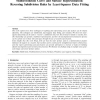Free Online Productivity Tools
i2Speak
i2Symbol
i2OCR
iTex2Img
iWeb2Print
iWeb2Shot
i2Type
iPdf2Split
iPdf2Merge
i2Bopomofo
i2Arabic
i2Style
i2Image
i2PDF
iLatex2Rtf
Sci2ools
CGF
1999
1999
Multiresolution Curve and Surface Representation: Reversing Subdivision Rules by Least-Squares Data Fitting
This work explores how three techniques for defining and representing curves and surfaces can be related efficiently. The techniques are subdivision, least-squares data fitting, and wavelets. We show how leastsquares data fitting can be used to "reverse" a subdivision rule, how this reversal is related to wavelets, how this relationship can provide a multilevel representation, and how the decomposition/reconstruction process can be carried out in linear time and space through the use of a matrix factorization. Some insights that this work brings forth are that the inner product used in a multiresolution analysis influences the support of a wavelet, that wavelets can be constructed by straightforward matrix observations, and that matrix partitioning and factorization can provide alternatives to inverses or duals for building efficient decomposition and reconstruction processes. We illustrate our findings using an example curve, greyscale image, and tensor-product surface.
| Added | 22 Dec 2010 |
| Updated | 22 Dec 2010 |
| Type | Journal |
| Year | 1999 |
| Where | CGF |
| Authors | Faramarz F. Samavati, Richard M. Bartels |
Comments (0)

